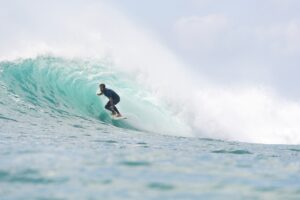Don’t Make These Common Beginner Surfer Mistakes

Surfing is an exhilarating sport that requires skill, patience, and a lot of practice. As a beginner, it’s natural to make mistakes on your first few days of surfing. However, by understanding and avoiding these common beginner surfer mistakes, you can improve your skills and enjoy the sport to its fullest.
In this article, we’ll discuss the top five beginner surfer mistakes and provide tips on how to avoid them.
Board Control
One of the most common mistakes beginners make is improper board control. Walking out with your board sideways, across your chest or stomach can cause injury. Always have your board next to you, held with both arms, nose pointing towards the ocean, making sure the nose goes up and over the waves. This way, you can avoid being pushed back by the waves.
Nose Diving/Pearling
The infamous nose dive, also known as a pearl, is a classic wipeout in the history of surfing. To prevent this wipeout, make sure that you are on your board correctly. Depending on the size of the surfer and the board, you want to be on your board so that it is lying flat as possible on the ocean surface. Finding the sweet spot where your body sits perfectly on the board is key to catching a wave correctly.
- Surfing Too
Close To The Crowd
Beginners often make the mistake of surfing too close to the crowd. It’s important to find a spot to yourself, away from the herd mentality. At a beach break, conditions are often not that different a few hundred yards down the beach from the crowd. When going out with a group of friends, try to leave a distance of about 10 feet between you. Make sure no one is in your lane before you take off on your wave.
Body Weight Distribution
Your board’s stringer, which goes down the middle from nose to tail, is your balancing point. Everything has to line up with that line. When lying down, it needs to slice down the middle of your body from head to feet. When your feet hit the deck, they need to be perpendicular to that line, and your knees should be bent. When you put your hands on the deck to start your pop up, they need to be symmetrically positioned next to your breast, or your board will start to squirrel, making it harder to get to your feet.
Incorrect Paddling
Paddling is the most critical part of surfing for beginners. To have a good, strong paddle, make sure your hands are cupped, and pretend you are scooping out the ocean. Keep your elbows high and take long, smooth strokes. Try to paddle with your whole body, not just your arms. If you’re not sure about your paddling technique, ask an experienced surfer to watch you and give you feedback.
In conclusion, surfing is a challenging but rewarding sport that requires practice, patience, and a willingness to learn. By avoiding these common beginner surfer mistakes and following our tips, you’ll be well on your way to improving your skills and enjoying the waves. Remember, surfing takes time and effort, but the rewards are well worth it. So, grab your board, hit the waves, and have fun!





